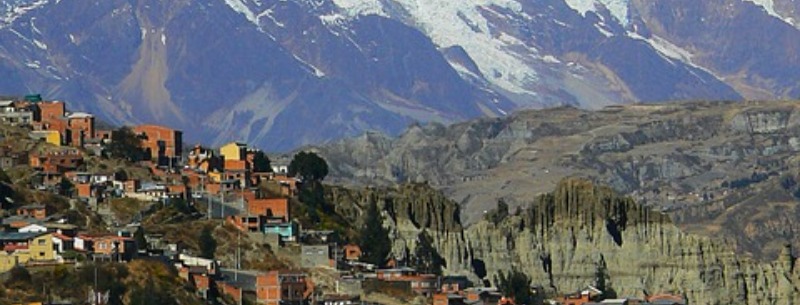La Paz, capital city of Bolivia
La Paz is a dizzying city, not just because of its high altitude. The Bolivian capital’s beauty is extraordinary, from the canyons and flat plains to the valley below. The city is meant to be savored and is best-suited to leisurely strolls and aimless wandering. Take the time to walk the narrow alleys, marvel at the fascinating museums, browse the eclectic offerings at the lively markets and chat with the locals in a traditional cafe. That is the best way to uncover the capital’s many faces and fully appreciate the beauty of La Paz.
To really immerse yourself in the local culture, explore the city’s many bustling markets. The traditional markets at the Calle Linares, Calle Sagarnaga and Calle Illampu are stocked with local handicrafts, artwork, and fresh produce, while the Mercado de las Brujas is for more superstitious shoppers. Known as the ìwitches’ market,î the cramped stalls sell everything from good luck charms and crystals to natural medicines and ingredients for potions.
Locals also love to gather at the Plaza Murillo, the city’s main square. Originally called the Plaza Mayor, space was rededicated to Pedro Domingo Murillo, one of the country’s most celebrated freedom fighters. Murillo was hanged on the site in 1810 and is immortalized in the square’s monument. During the day, locals head to the square to relax, soak in the sun and feed the pigeons, but at night, the square is often filled with musicians playing traditional music.
Just south of the plaza is the Presidential Palace, a grand building first constructed in 1852. The palace has been modified and rebuilt so many times due to fire damages that it has earned the nickname ìPalacio Quemado,î or ìBurning Palace.î Presidential guards stand watch over the entrances, but visitors can see a statue of Gualberto Villarroel, the former president who was hanged by a mob in 1946.
La Paz is home to a number of impressive churches, and one of the most interesting is the Catedral de Nuestra Senora de La Paz. The simple stone building was built in 1835 near the city’s first mission. The church’s real treasure is its interior, centered around a dazzling gold altar.
The Iglesia de San Francisco is also worth a visit. The mid-16th century building actually predates the capital’s establishment, but the church was largely destroyed due to snow in 1610. Rebuilt in 1794, the renovated cathedral features a mix of Spanish Baroque and mestizo style. The artwork inside is rich with traditional symbols like snakes, tropical birds and dragons.
One of the best ways to better understand the country and its people is to visit the Museo de Etnografia y Folklore. Small but thought-provoking, the museum features exhibits dedicated to Bolivia’s diverse ethnic cultures. The ground floor showcases colorful local masks while the upper floor contains a replica of the village of Uru Chipaya, featuring models of traditional buildings and exhibits about local hunting techniques. There is also an extensive audio-visual library and regular showings about the country’s traditional dances, music and customs.
The Museo del Charango is another favorite of both visitors and locals. The museum traces the history of traditional music and features a large collection of charangos and other Bolivian folk instruments.
Other museums worth exploring in the capital include the Museum of Precious Metals, the Museum of Contemporary Art, the Bolivian Andean Textile Museum and the Submerged Museum, a small outdoor plaza with a Tiwanaku monolith in the center.
La Paz Geographical Location
La Paz is located in the central west of Bolivia in the valleys of the Andes.
La Paz is the second most populated city in Bolivia, after Santa Cruz de la Sierra, with approximately 2,365,000 inhabitants.
La Paz Language
Spanish, Quechua, and Aymara are the official languages of Bolivia.
La Paz Predominant Religion
- 95% Roman Catholic
- 5% Protestant
Although Roman Catholic is the predominant religion, a much smaller percentage is practicing in the traditional sense.
La Paz Currency
The Boliviano is the official currency of Bolivia.
La Paz Climate
La Paz is consistently cool throughout the year due to its high altitude. The rainiest months are between December and March in which the majority of the year’s rainfall occurs.
La Paz Main Attractions
- Tiwanaku
- Valle de la Luna
- Death Road (El Camino de la Muerte)
Other Attraction in La Paz
- Iglesia de San Francisco
- Huayna Potosi
- Presidential Palace
- Plaza Murrillo
